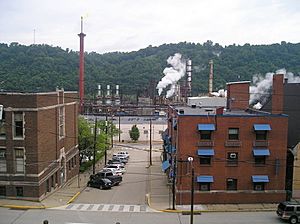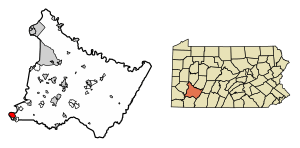Monessen, Pennsylvania facts for kids
Quick facts for kids
Monessen, Pennsylvania
|
|||
|---|---|---|---|

Downtown Monessen
|
|||
|
|||
| Etymology: Monongahela + |
|||

Location of Monessen in Westmoreland County, Pennsylvania
|
|||
| Country | |||
| State | |||
| County | Westmoreland | ||
| Settled | 1897 | ||
| Borough incorporated | September 3, 1898 | ||
| City incorporated | September 16, 1921 | ||
| Area | |||
| • Total | 3.02 sq mi (7.83 km2) | ||
| • Land | 2.89 sq mi (7.48 km2) | ||
| • Water | 0.14 sq mi (0.35 km2) | ||
| Elevation | 1,128 ft (344 m) | ||
| Population
(2020)
|
|||
| • Total | 6,876 | ||
| • Density | 2,381.71/sq mi (919.58/km2) | ||
| Time zone | UTC-5 (EST) | ||
| • Summer (DST) | UTC-4 (EDT) | ||
| ZIP Code |
15062
|
||
| Area code(s) | 724 | ||
| FIPS code | 42-50344 | ||
| School District | Monessen City School District | ||
Monessen is a city in southwestern Westmoreland County, Pennsylvania, United States. It is located along the Monongahela River. In 2020, about 6,876 people lived there.
Monessen was once famous for its steel-making industry. It became a city in 1921. After the steel industry changed in the late 1900s, many jobs were lost. Monessen is now part of the "Mon Valley" in southwestern Pennsylvania. It is also part of the larger Pittsburgh metropolitan area. The city is across the Monongahela River from North Charleroi.
Contents
History of Monessen
How Monessen Began

Monessen got its name from the Monongahela River and the industrial German city of Essen. It was founded later than other towns in the Mon Valley. A group called the East Side Land Company bought land from farmers. They planned the streets and sold lots to people and businesses.
One important investor was James M. Schoonmaker, who made a lot of money from coke. Other investors, whose names are now on streets, included Philander C. Knox and James H. Reed. In May 1897, the National Tin Plate Company started building its factory. This was Monessen's first big employer. People started buying land lots on July 27, 1897. Monessen officially became a borough on September 3, 1898.
Growth and Challenges in the 1900s
Monessen grew very quickly in the early 1900s. Its population jumped from 2,197 in 1900 to 18,179 by 1920. Many companies operated in Monessen. The biggest employer was Pittsburgh Steel Company, later called Wheeling-Pittsburgh Steel.
Workers often had long hours, sometimes 12 hours a day, seven days a week. The eight-hour workday did not become common until the 1920s. On September 16, 1921, Monessen changed from a borough to a city.
Starting in the mid-1960s, it became harder for local factories, especially steel mills, to compete. This led to many job losses. In 1972, the Page Steel and Wire Company closed. A much bigger impact happened when Wheeling-Pittsburgh Steel closed most of its Monessen operations in 1986. The last part of the mill closed in March 1987. This marked the end of an important time in Monessen's history.
For many years, the city has worked to clean up empty buildings. This helps to make the city better. In January 2010, Mary Jo Smith became the first female mayor of Monessen. Older residents know that the steel mills will not return. Younger residents might not even remember the city's industrial past.
Monessen in the 2000s
The Charleroi-Monessen Bridge was built in 1906 and taken down in 2011. It was a historic landmark. Monessen has many military veterans who served in different wars. There are many memorials and plaques in the city to honor them.
Some well-known memorials include:
- The WWI Lady Victory Memorial in Eastgate.
- The Honor Roll at the City Park, listing all who served.
- The WWII Sherman Tank Memorial in the City Park.
- The Capt John Onderko Memorial Walking Track.
- The Lt Col Edward D'Alfonso Memorial Amphitheater.
- The SP4 Robert Lhota Memorial Picnic Shelter.
- The George Milika Memorial Picnic Shelter.
- The Anthony Madison Memorial Picnic Shelter.
Monessen has a War Veterans Memorial Trust to help take care of these memorials.
Geography and Climate
Where is Monessen Located?
Monessen is located at 40°9′15″N 79°52′58″W / 40.15417°N 79.88278°W. The city covers about 3.1 square miles (7.83 square kilometers). Most of this area is land, with a small part being water.
Monessen is part of the Greater Pittsburgh area.
What is Monessen's Climate Like?
Monessen has a climate with hot, humid summers. Winters are usually mild to cool. This type of climate is called a humid continental climate.
| Climate data for Monessen, Pennsylvania | |||||||||||||
|---|---|---|---|---|---|---|---|---|---|---|---|---|---|
| Month | Jan | Feb | Mar | Apr | May | Jun | Jul | Aug | Sep | Oct | Nov | Dec | Year |
| Mean daily maximum °F (°C) | 39 (4) |
43 (6) |
55 (13) |
66 (19) |
75 (24) |
82 (28) |
86 (30) |
84 (29) |
79 (26) |
68 (20) |
55 (13) |
44 (7) |
65 (18) |
| Daily mean °F (°C) | 29 (−2) |
32 (0) |
43 (6) |
52 (11) |
62 (17) |
70 (21) |
74 (23) |
73 (23) |
67 (19) |
55 (13) |
45 (7) |
34 (1) |
53 (12) |
| Mean daily minimum °F (°C) | 20 (−7) |
22 (−6) |
31 (−1) |
39 (4) |
49 (9) |
57 (14) |
62 (17) |
61 (16) |
55 (13) |
43 (6) |
35 (2) |
25 (−4) |
41 (5) |
| Average precipitation inches (mm) | 2.9 (74) |
2.4 (61) |
3.5 (89) |
3.4 (86) |
3.8 (97) |
3.8 (97) |
3.7 (94) |
3.6 (91) |
3 (76) |
2.5 (64) |
2.9 (74) |
2.7 (69) |
38 (970) |
| Average snowfall inches (cm) | 7.3 (19) |
4.7 (12) |
3.7 (9.4) |
0.4 (1.0) |
0.0 (0.0) |
0.0 (0.0) |
0.0 (0.0) |
0.0 (0.0) |
0.0 (0.0) |
0.0 (0.0) |
1.3 (3.3) |
4.1 (10) |
21.5 (55) |
| Source: Weatherbase | |||||||||||||
Neighboring Areas
Monessen shares a land border with Rostraver Township. Across the Monongahela River, in Washington County, Monessen is next to Carroll and Fallowfield Townships. It is also near North Charleroi.
Population Facts
| Historical population | |||
|---|---|---|---|
| Census | Pop. | %± | |
| 1900 | 2,197 | — | |
| 1910 | 11,775 | 436.0% | |
| 1920 | 18,179 | 54.4% | |
| 1930 | 20,268 | 11.5% | |
| 1940 | 20,257 | −0.1% | |
| 1950 | 17,896 | −11.7% | |
| 1960 | 18,424 | 3.0% | |
| 1970 | 15,216 | −17.4% | |
| 1980 | 11,928 | −21.6% | |
| 1990 | 9,901 | −17.0% | |
| 2000 | 8,669 | −12.4% | |
| 2010 | 7,720 | −10.9% | |
| 2020 | 6,876 | −10.9% | |
| Sources: | |||
In 2010, Monessen had 8,669 people living in 3,916 households. About 2,451 of these were families. The city had about 2,987 people per square mile.
Most of the people in Monessen were White (83.71%). About 13.99% were African American. A small number were Native American, Asian, or from other backgrounds. About 0.82% of the population was Hispanic or Latino. Many residents had Italian, Slovak, German, or Polish family backgrounds.
About 21.2% of households had children under 18. About 42.9% were married couples. The average household had 2.19 people. The average family had 2.80 people.
The population included:
- 19.6% under 18 years old.
- 5.3% from 18 to 24 years old.
- 23.3% from 25 to 44 years old.
- 22.7% from 45 to 64 years old.
- 29.1% who were 65 years or older.
The average age in Monessen was 46 years.
Education in Monessen
- Douglas Education Center is a private school in Monessen. It helps students learn skills for different careers.
- Monessen City School District is the public school system for the city.
Famous People from Monessen
Many notable people have connections to Monessen:
- Christian B. Anfinsen (1916-1995), a biochemist who won a Nobel Prize.
- Steve Belichick (1919-2005), an NFL player and college coach.
- Tony Benjamin (1955-), a football player.
- Eric Crabtree (1944-), an NFL Football Player.
- Doug Crusan (1946-), an NFL Football Player.
- Artis Leon Ivey Jr. (1963-2022), a Grammy Award-winning rapper and actor known as Coolio.
- Nicholas P. Kafkalas (1920–2013), a US Army major general.
- Philander C. Knox (1852-1921), a United States Senator and one of Monessen's founders.
- Albert Lexie, a shoeshiner famous for giving a lot of his earnings to charity.
- Bill Malinchak (1944-), a former football player.
- Frances McDormand, an Oscar-winning American actress.
- Herman Mihalich (1930-1997), a former member of the Pennsylvania House of Representatives.
- Michael Moorer, a former heavyweight boxing champion.
- Armand Niccolai (1911-1988), a former NFL player for the Pittsburgh Steelers.
- Lawrence T. Persico, a Bishop in the Roman Catholic Church.
- James H. Reed (1853-1927), a United States federal judge and one of Monessen's founders.
- Tom Savini, a makeup artist.
- James M. Schoonmaker (1842-1927), an American Civil War Colonel and one of Monessen's founders.
- Blanche Thebom, a mezzo-soprano singer.
- Floyd "Chip" Ganassi Jr. (born 1958), a businessman and former racing driver.
See also
 In Spanish: Monessen para niños
In Spanish: Monessen para niños





